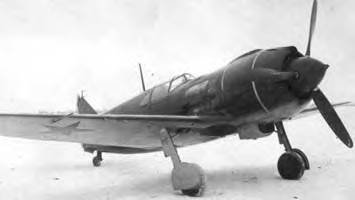The Lavochkin series of fighters were among the best fighters produced during World War II. As a dogfighter, the Lavochkin La 5 was considered a superior aircraft to both the German Bf 109 and Fw 190 fighters. The La 5 was the fighter of choice for Soviet aces. Ivan Kozhedub brought down 62 German planes in an La 5FN (a fuel injection version of the La 5).
The Lavochkin La 5 was designed by Semyon Lavochkin in late 1941. The German blitzkrieg was advancing on Moscow and the Soviets desperately needed to take back air superiority from Germany. Lavochkin took the LaGG 3 airframe and began to modify it into the viable and deadly La 5. To the LaGG frame Lavochkin added the powerful M-82 radial engine. With a few aerodynamic retouches, a new canopy and cowl, Lavochkin had produced a fighter that was faster and more agile then the much-feared Bf 109. For his design of the La 5 and all planes bearing his name, Lavochkin received the esteemed Stalin Prize.
The La 5 first saw combat in the Battle of Stalingrad in 1942. Showing good results there, a new version was created, the La 5FN. It had a fuel injected engine which produced better response during aerobatics. The new version arrived during the Battle at Kursk further improving the Lavochkin La 5’s reputation.
21,975 of the various Lavochkin Russia airplane models were produced. They left service in 1945.
| Type | Fighter |
| Power Plant | 1 x 1,859-horsepower Shvetsov M-82/M-82FN radial engine. |
| Max speed: | 665 Km/h (413 mph) |
| Ceiling: | 10,800 m (35,435 ft.) |
| Range: | 635 km (395 mi.) |
| Weight (empty): | 2,638 kg (5,816 lb.) |
| Weight (loaded): | 3,400 kg (7,496 lb.) |
| Wingspan: | 9.75 m (32 ft. 2 in.) |
| Length: | 8.55 m (28 ft. 2 in.) |
| Height: | 2.83 m (9 ft. 3 in.) |
| Armament: | 2 x 20 mm cannons; up to 441 pounds of bombs |
| Service | 1944 – 1945 |

